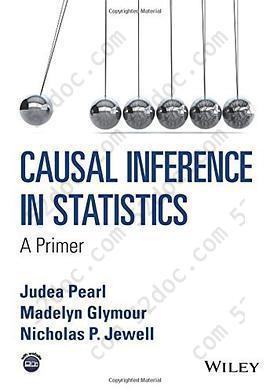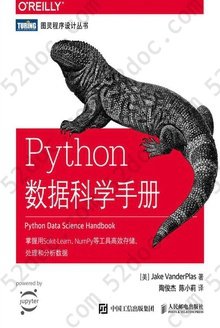注重体验与质量的电子书资源下载网站
分类于: 人工智能 编程语言
简介

Causal Inference in Statistics: A Primer 豆 8.8分
资源最后更新于 2020-08-23 08:21:20
作者:Judea Pearl
出版社:Wiley
出版日期:2016-01
ISBN:9781119186847
文件格式: pdf
标签: 因果推理 statistics Causality 因果推断 计算机科学 研究方法 統計學 数学
简介· · · · · ·
Causality is central to the understanding and use of data. Without an understanding of cause effect relationships, we cannot use data to answer questions as basic as, “Does this treatment harm or help patients?” But though hundreds of introductory texts are available on statistical methods of data analysis, until now, no beginner-level book has been written about the exploding...
目录
Preface xi
1 Preliminaries: Statistical and Causal Models 1
1.1 Why Study Causation 1
1.2 Simpson’s Paradox 2
1.3 Probability and Statistics 9
1.3.1 Variables 10
1.3.2 Events 11
1.3.3 Conditional probability 11
1.3.4 Independence 13
1.3.5 Probability distributions 14
1.3.6 The law of total probability 15
1.3.7 Using Bayes’ rule 18
1.3.8 Expected values 22
1.3.9 Variance and covariance 24
1.3.10 Regression 27
1.3.11 Multiple regression 31
1.4 Graphs 33
1.5 Structural Causal Models 36
1.5.1 Modeling causal assumptions 36
1.5.2 Product decomposition 40
2 Graphical Models and Their Applications 47
2.1 Connecting Models to Data 47
2.2 Chains and Forks 48
2.3 Colliders 55
2.4 ��-Separation 62
2.5 Model Testing and Causal Search 66
3 The Effects of Interventions 71
3.1 Interventions 71
3.2 The Adjustment Formula 74
3.2.1 To adjust or not to adjust? 79
3.2.2 Multiple interventions and the truncated product rule 81
3.3 The Back-Door Criterion 82
3.4 The Front-Door Criterion 89
3.5 Conditional Interventions and Covariate-Specific Effects 95
3.6 Inverse Probability Weighing 98
3.7 Mediation 103
3.8 Causal Inference in Linear Systems 107
3.8.1 Structural vs. regression coefficients 110
3.8.2 The causal interpretation of structural coefficients 111
3.8.3 Identifying structural coefficients and causal effect 113
3.8.4 Mediation in linear systems 119
4 Counterfactuals and their Applications 123
4.1 Counterfactuals 123
4.2 Defining and Computing Counterfactuals 126
4.2.1 The structural interpretation of counterfactuals 126
4.2.2 The fundamental law of counterfactuals 130
4.2.3 From population data to individual behavior – an illustration 131
4.2.4 The three steps in computing counterfactuals 133
4.3 Non-Deterministic Counterfactuals 136
4.3.1 Probabilities of counterfactuals 136
4.3.2 The Graphical representation of counterfactuals 141
4.3.3 Counterfactuals in experimental settings 144
4.3.4 Counterfactuals in linear models 147
4.4 Practical uses of counterfactuals 149
4.4.1 Recruitment to a program 149
4.4.2 Additive interventions 152
4.4.3 Personal decision making 155
4.4.4 Sex discrimination in hiring 158
4.4.5 Mediation and path-disabling interventions 159
4.5 Mathematical Tool Kits for Attribution and Mediation 161
4.5.1 A tool kit for attribution and probabilities of causation 162
4.5.2 A tool kit for mediation 167
References 176
1 Preliminaries: Statistical and Causal Models 1
1.1 Why Study Causation 1
1.2 Simpson’s Paradox 2
1.3 Probability and Statistics 9
1.3.1 Variables 10
1.3.2 Events 11
1.3.3 Conditional probability 11
1.3.4 Independence 13
1.3.5 Probability distributions 14
1.3.6 The law of total probability 15
1.3.7 Using Bayes’ rule 18
1.3.8 Expected values 22
1.3.9 Variance and covariance 24
1.3.10 Regression 27
1.3.11 Multiple regression 31
1.4 Graphs 33
1.5 Structural Causal Models 36
1.5.1 Modeling causal assumptions 36
1.5.2 Product decomposition 40
2 Graphical Models and Their Applications 47
2.1 Connecting Models to Data 47
2.2 Chains and Forks 48
2.3 Colliders 55
2.4 ��-Separation 62
2.5 Model Testing and Causal Search 66
3 The Effects of Interventions 71
3.1 Interventions 71
3.2 The Adjustment Formula 74
3.2.1 To adjust or not to adjust? 79
3.2.2 Multiple interventions and the truncated product rule 81
3.3 The Back-Door Criterion 82
3.4 The Front-Door Criterion 89
3.5 Conditional Interventions and Covariate-Specific Effects 95
3.6 Inverse Probability Weighing 98
3.7 Mediation 103
3.8 Causal Inference in Linear Systems 107
3.8.1 Structural vs. regression coefficients 110
3.8.2 The causal interpretation of structural coefficients 111
3.8.3 Identifying structural coefficients and causal effect 113
3.8.4 Mediation in linear systems 119
4 Counterfactuals and their Applications 123
4.1 Counterfactuals 123
4.2 Defining and Computing Counterfactuals 126
4.2.1 The structural interpretation of counterfactuals 126
4.2.2 The fundamental law of counterfactuals 130
4.2.3 From population data to individual behavior – an illustration 131
4.2.4 The three steps in computing counterfactuals 133
4.3 Non-Deterministic Counterfactuals 136
4.3.1 Probabilities of counterfactuals 136
4.3.2 The Graphical representation of counterfactuals 141
4.3.3 Counterfactuals in experimental settings 144
4.3.4 Counterfactuals in linear models 147
4.4 Practical uses of counterfactuals 149
4.4.1 Recruitment to a program 149
4.4.2 Additive interventions 152
4.4.3 Personal decision making 155
4.4.4 Sex discrimination in hiring 158
4.4.5 Mediation and path-disabling interventions 159
4.5 Mathematical Tool Kits for Attribution and Mediation 161
4.5.1 A tool kit for attribution and probabilities of causation 162
4.5.2 A tool kit for mediation 167
References 176








